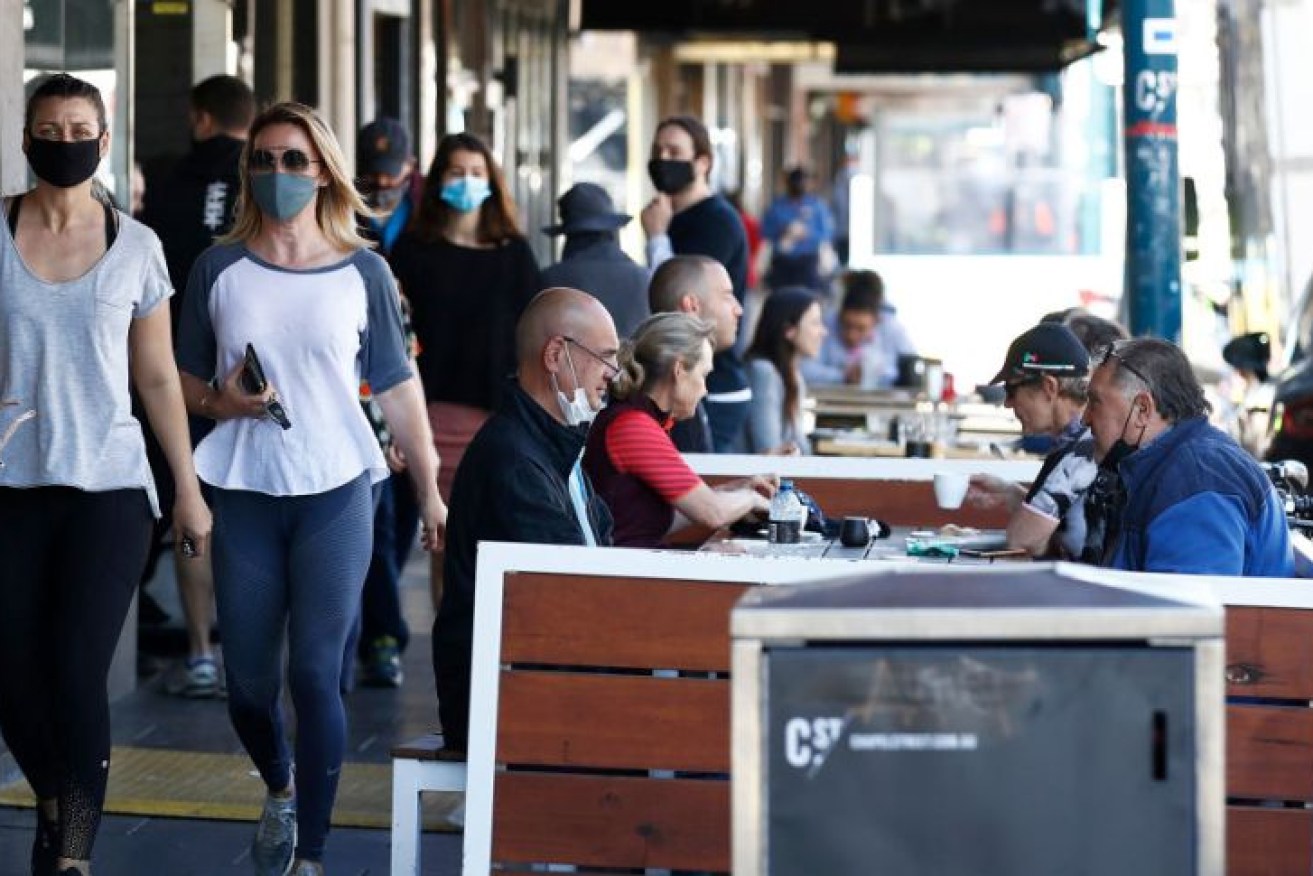One perfect day: Australia has pushed virus cases down to zero – but can we stay there?
It’s taken almost five months, millions of people going into lockdown, and a significant amount of sacrifice. But on Sunday, for the first time since June, Australia achieved a day with no locally acquired cases of COVID-19.

Elimination of COVID-19 is considered more than 28 days with no locally acquired cases of an unknown source.(Getty Images: Daniel Pockett)
It’s an impressive and — as Victorians will tell you — hard-won achievement.
But it was also short-lived: On Monday New South Wales recorded one new COVID-19 case, and multiple alerts were issued for Western Sydney.
Still, with new case numbers at their lowest in months, is it possible for Australia to get back down to zero — and stay there? And even put coronavirus elimination within our sights?
Suppression more ‘realistic’ than elimination
Australia’s approach to COVID-19 has never been to pursue its elimination — generally considered to be 28 days of no locally acquired infections (of an unknown source).
Instead, we’ve chosen to tackle the epidemic with a strategy known as “aggressive suppression”.
The goal, as outlined by the Federal Government, is to have no community transmission — with the caveat that some cases will pop up, and that outbreaks remain a risk.
The success of the strategy relies on finding new cases early and stopping chains of transmission.
Part of the challenge of eliminating COVID-19 is that it can spread undetected at low levels because you can transmit the virus even if you don’t have any symptoms.
But even with no or very low cases, infectious diseases epidemiologist Professor James McCaw says an elimination strategy is essentially futile while the pandemic rages on overseas.
“While we might be able to eliminate the virus from the population, we can never eliminate the risk that it poses while it continues to circulate globally,” he says.
“Elimination is not a bad thing … but there is a difference between welcoming elimination and having it as a strategy — because we expect [the virus] will come back in.”
McCaw, who is an expert adviser on the Australian Health Protection Principal Committee (which advises the National Cabinet), says even a water-tight quarantine system isn’t a guarantee of keeping COVID-19 out.
“The hotel quarantine system, [which lasts] 14 days, is world best practice — around 99 per cent of people are no longer infectious after those 14 days,” he says.
“But if you’ve got hundreds of thousands of people coming into the country, and we’ve already had over 100,000 through the hotel quarantine system … 1 per cent is still quite a lot of people.”
Infectious disease epidemiologist Meru Sheel agrees, saying without a COVID-19 vaccine, suppression remains a more realistic approach than elimination.
“I don’t think in the current climate, and from what we’ve seen globally, that elimination is a feasible option,” Dr Sheel, of the Australian National University, says.
“New Zealand, who was going for elimination, after a few months they did see cases.
“Focusing on a strong suppression and active response is probably a more realistic way of looking at it.”
Same objective, different approaches
Epidemiologist Professor Tony Blakely was one of several public health experts calling for Australia to change tack to elimination in July, as Victoria’s second-wave hit.
Proponents of elimination argue that tougher lockdowns in the short-term allow for longer periods of economic prosperity and laxer social restrictions.
Professor Blakely says that occasional reintroductions of the virus — as have been seen in New Zealand — don’t make elimination a pointless strategy.
“Elimination is as much a process as anything,” he says. “You’re basically aiming to get elimination of community transmission, and then when it pops up again, you land on it and get rid of it again.”

New Zealand, who adopted an elimination strategy, detected COVID-19 after more than 100 days without community transmission. (Photo: Getty Images: Hagen Hopkins)
Even so, Blakely says he’s changed his mind about Australia since July, and come round to the idea that aggressive suppression is the best way to go.
“I think in the Australian context, because of the number of people here, the different state borders, and the politics … a somewhat less intense approach than what’s used in New Zealand is better,” he says.
As strategies go, elimination and aggressive suppression have “the same things in the tool kit”, Blakely says.
The difference is in how intensively and for how long you apply those measures.
“It’s trying to work out what’s best for your society given how the politics works, population size, the fact you’ve got borders that are open or closed,” he says.
“Any of these suppression approaches that are being adopted in East Asia and Australasia — they all have a probability of achieving community elimination, that probability just differs with how intense you apply that strategy.”
Australia is one of a small number of jurisdictions — including mainland China, Hong Kong, Taiwan, South Korea, Fiji and New Zealand — pursuing COVID-19 suppression or elimination.
Past experience with SARS, or in Australia’s case, being “down the bottom of the world” and having “a few more weeks to react”, put these countries on the course to keep case numbers low, Blakely says.
“We’ve taken a different path to what Europe and North America have … where we try to keep the numbers really, really low,” he says.
“It means you’ve got to use lockdown at both ends — controlling disasters but also to get your numbers down — and that has been painful.
“But all the modelling we’re doing suggests that this is a better approach in the long run. You only need to look at the UK to see that.”
Accepting risk as state borders open
Despite not having an elimination strategy, most Australian states and territories have managed to achieve a sustained period of no locally acquired cases for several months.
Epidemiologist Jodie McVernon says Australia’s ability to contain new coronavirus infections had even surprised public health experts.
“Right back in the beginning, we were looking to flatten the curve and keep [COVID-19] within our public health and clinical capacity,” says Professor McVernon, director of epidemiology at The Doherty Institute.
“Elimination was kind of a surprising by-product of those first set of controls.”
McVernon, who is also an expert adviser on the AHPPC, says Victoria and New South Wales were “always going to find it hardest” because of their population size and density, and higher rate of international arrivals.
She says the experience of both states demonstrated why aggressive suppression was the right approach.
“[NSW] is exactly the model of saying: you can still have relative openness of society and the economy, but keep this under control,” Professor McVernon says.
“It’s a pragmatic strategy that recognises we are still connected to the wider world … and that infections will re-seed.”

Physical distancing measures will remain in place until a vaccine is available, experts say.(Getty Images: James D. Morgan)
Blakely says the likelihood of Victoria or New South Wales achieving elimination was less than 50 per cent, but that enforcing further restrictions would be disproportionate to the current situation.
“If [Victoria] hadn’t opened up … the probability of elimination would have gone up. But so would have the social and economic cost,” he said.
“With the borders about to be opened up, [the virus] is going to hop around a lot more easily.
“But it doesn’t make [elimination] impossible. The chance of it happening now largely depends on how good the contact tracing is, how well the population behaves, and a lot of luck.”
The road ahead
Under an aggressive suppression strategy, McCaw says Australia should expect to see small coronavirus clusters popping up until a vaccine arrives.
“We expect to see them because either the virus is still around and hard to detect, and occasionally flares up,” he says, “or we actually eliminate it for a period of time and then it comes back in.”
To minimise the chance of clusters or outbreaks escalating, he says we all need to continue to observe social distancing rules and “act in a COVID-safe way”.
All four epidemiologists agree that Australia’s contact-tracing has improved, and that increased knowledge of the virus means health authorities are in a better position to keep case numbers low.
Dr Sheel says putting a “ring fence” around every new case and tracing contacts of contacts is essential to managing future COVID-19 clusters.
“The speed at which we respond to each cluster really plays a role now.”
– ABC / Olivia Willis












